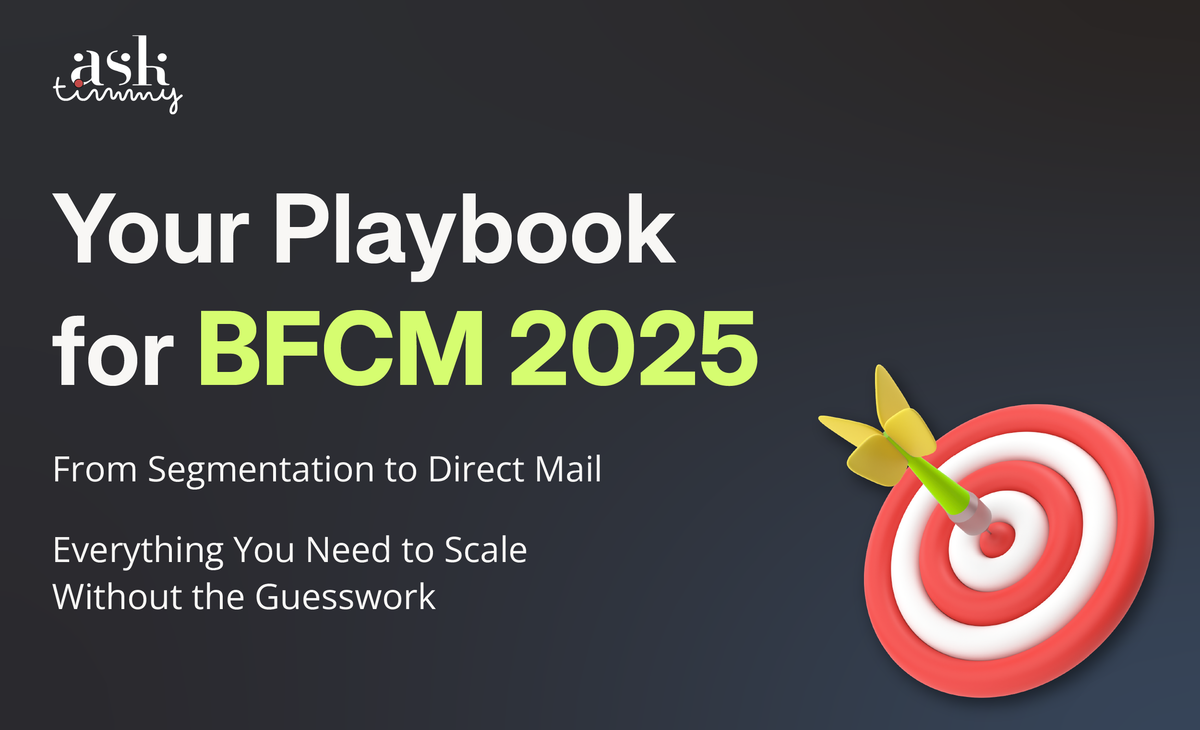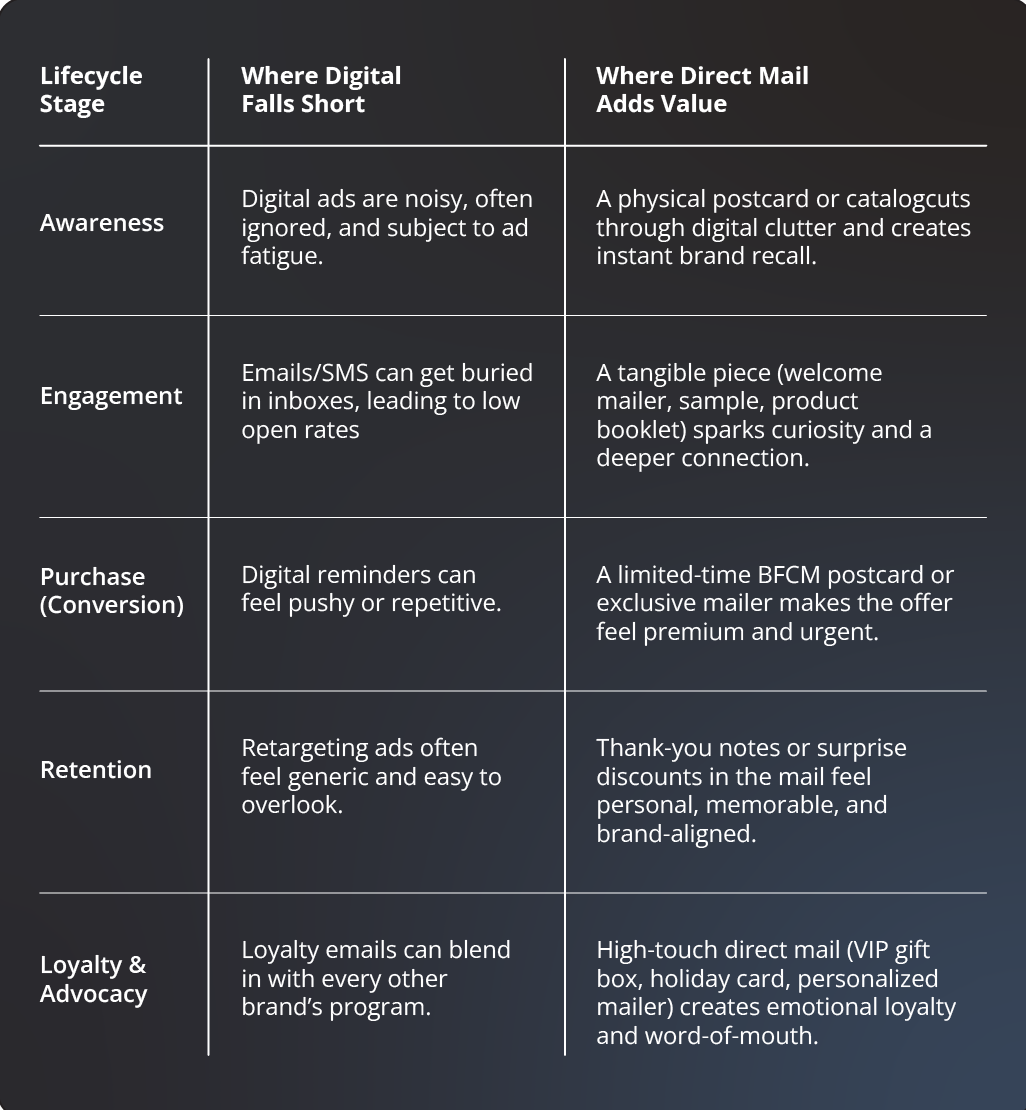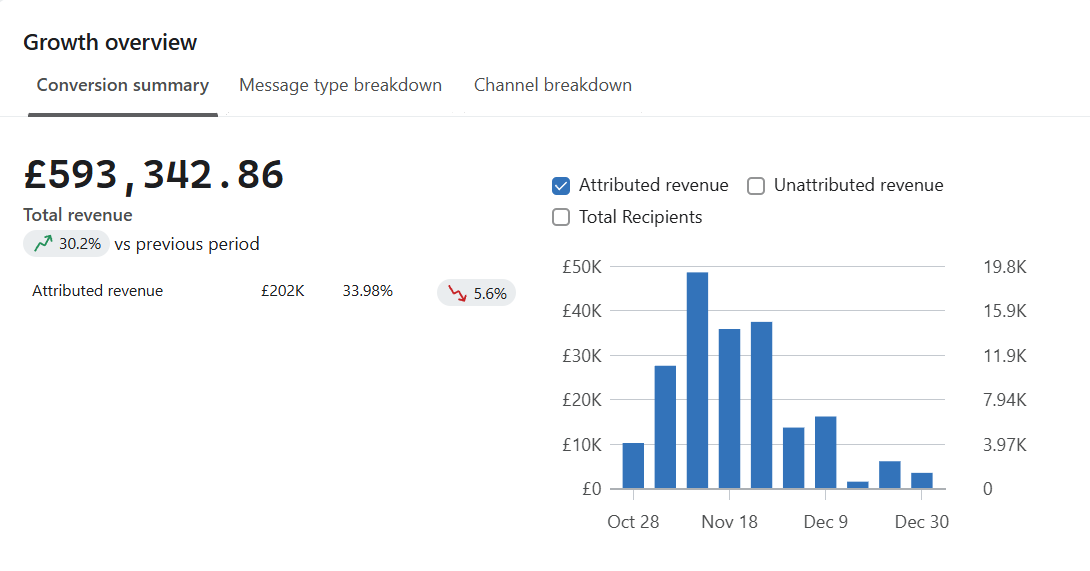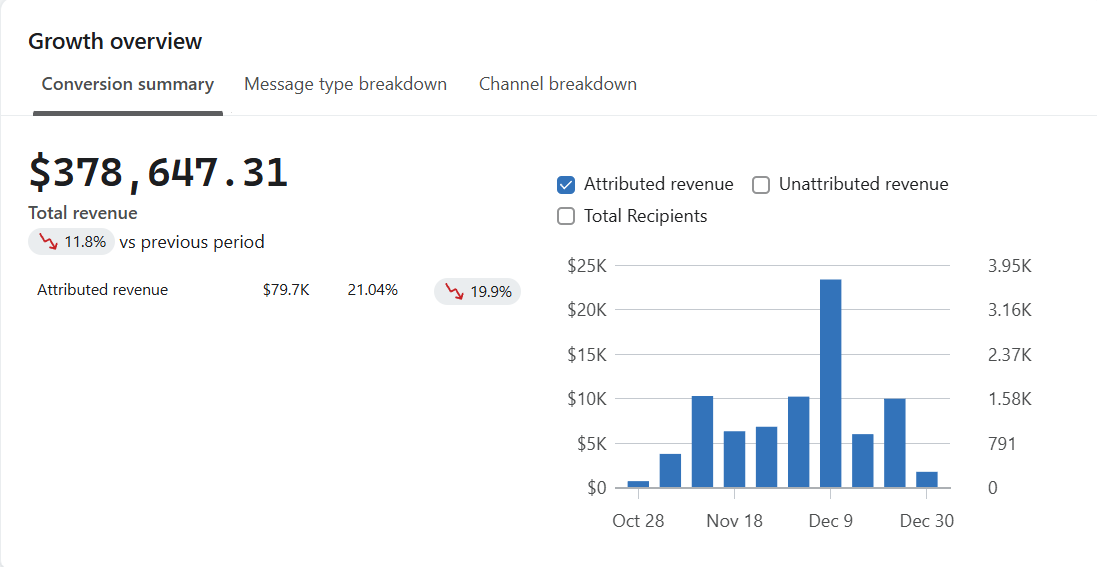What Most BFCM Guides Miss (And How to Win in 2025)
BFCM 2025: Segmentation to direct mail, everything you need to scale your brand.

Black Friday Cyber Monday (BFCM) isn’t just a weekend anymore; it’s a month-long retail marathon. Shoppers start hunting for deals earlier, inboxes are flooded with discounts, and competition for attention is fiercer than ever.
- Klaviyo reported over 5 billion emails sent during BFCM 2024.
- Holiday shopping grew by 8.7% in 2024 to a whopping $241.1 billion.
- 41% consumers only check emails for deals and promos.
So if your strategy is still “send one big sale email on Black Friday,” chances are you’ll be drowned out…or worse, land in the spam folder.
The Problem With the Old Playbook
The BFCM landscape has shifted. What worked even a couple of years ago no longer guarantees results. Here’s why:
- Early launches. Brands roll out “early access” and pre-sales weeks before Black Friday. Delay, and you’re invisible.
- Margins under pressure. Blanket sitewide discounts combined with rising ad costs mean lower profits unless you design smarter offers.
- Deliverability risks. Sending 5x your usual volume without proper warmup and segmentation triggers spam filters.
- Creative fatigue. Everyone shouts, “50% OFF.” Without a unique angle, your message blends into the noise.
- Operational strain. Stockouts, slow shipping, and overwhelmed support teams can erase promo gains if marketing isn’t aligned with operations.
Conclusion: A copy-paste BFCM strategy puts you at risk of poor results, even if your discount is steep.
Don’t worry, we’ve developed this guide to walk you through strategies, best practices, and tricks of the trade to help your business reap the best of BFCM.
What Your Black Friday Strategy Is Missing
Most brands follow the same checklist every year: start early, send a few VIP offers, and hope bigger discounts will carry the season. That’s not enough anymore. Here are six areas where most teams fall short:
Put Your Best Offer on the Table
Shoppers are flooded with deals. If your discount looks weak compared to competitors, they’ll move on. This is the moment to run your strongest promotion of the year. If you’re hesitant, remember: Black Friday is about stretching out the margin, maximizing revenue, and customer acquisition in the biggest buying window.
Increased AOV with Intent
Raising your average order value (AOV) isn’t about luck. Use:
- Tiered discounts (spend $100, get 20% off; spend $150, get 30%).
- Bundled products (gift sets, best-seller packs).
- Free shipping thresholds ($75+).
Shoppers are primed to spend more. Structure your offer so it feels natural to add one more item. Because high AOV means:
- Boost in sales
- Higher revenue
- Faster profitability
- Greater ROI
- Increased customer LTV
Spend More on Meta
Yes, CPMs are higher. But buyer intent is also at its peak. Pulling back on Meta spend means you miss the cheapest acquisition window of the year in terms of future LTV. The key is to track CAC relative to expected repeat purchase behavior, not just ROAS in the moment.
Expand Your Audience with Paid Ads
Black Friday is an opportunity to reach new buyers who are ready to shop. Paid ads are one of the most effective levers, but timing matters.
Here’s a simple timeline to follow:
- 2 months before BFCM:
Build momentum early. Use lookalike audiences based on your best customers (high spenders, repeat buyers, or VIPs) to attract new leads. The earlier you bring them in, the more time you have to nurture them before the sales hit.
- 1 month before BFCM:
Focus on re-engagement. Target lapsed customers and inactive subscribers with ad campaigns that remind them why they loved your brand in the first place. Think product spotlights, seasonal content, or even exclusive “warm-up” offers.
- During BFCM weekend:
This is the time to go after the low-hanging fruit. Target active site visitors, engaged email subscribers, and abandoned cart audiences. Pair urgency-driven ad creative with your strongest offer.
- During and after BFCM:
Don’t waste ad spend on people who have already converted. Exclude BFCM purchasers from your campaigns, and shift your budget to upsell, cross-sell, or winback flows for December shoppers.
Build Content for Share of Wallet
Remember: you’re not only competing with brands in your niche, you’re competing with everything on someone’s holiday list. If a shopper has $500 to spend, how do you make sure a bigger slice goes to you?
That’s where share of wallet placements come in: gift guides, curated bundles, high-intent ads, and content that positions your brand as the obvious holiday choice.
Send More Emails
If you’re worried about sending too many emails, don’t be. This is the one time of year your customers expect to hear from you. A strong BFCM flow looks like:
- Hype emails pre-launch.
- Launch-day blast.
- Reminder nudges.
- Last-chance urgency.
Inbox presence = cart presence.
Direct Mail’s Role in Winning BFCM 2025 Strategy
When most people think about Black Friday and Cyber Monday, email and SMS are the first channels that come to mind, and rightly so. They’re fast, cost-effective, and reach your audience instantly.
But here’s the problem: during BFCM, inboxes are overflowing. Every brand is fighting for attention, and your message can easily get lost in the noise.
That’s where direct mail comes in. It may feel old-school, but in a world of digital overload, physical mail has a unique advantage: it’s tangible, personal, and much harder to ignore.
Customer LTV is typically 2-3 times higher when direct mail is combined with email and SMS.
Why Direct Mail Belongs in Your Lifecycle Strategy:
ROI That Outpaces Its Cost
Direct mail isn’t cheap, but it delivers. Brands consistently see higher ROI compared to digital-only campaigns, if done right. Also, the cost doesn’t spike as you scale; your 10,001st send costs nearly the same as your 1,001st.
Think of it as a long-term investment in loyalty and conversions, not just a one-time expense.
Precision Beats Volume
Direct mail speaks directly to an individual; no banner ad or email can. But this requires discipline:
- Who is this person?
- What messaging resonates with them?
- How can we align with what we already know from the website, SMS, email, and other digital data?
When brands go for full sends, they lose money and impact. What wins is precision targeting/segmentation. Prioritize thoughtfulness, targeting, and relevance.
A Cross-Departmental Effort
Direct mail isn’t a one-person show. To succeed, you’ll need:
- Marketing teams to craft the message.
- Data and analytics teams to identify the right segments.
- Customer experience teams to ensure the message matches the journey.
This collaboration turns a physical mailer into a brand-aligned moment that customers actually remember.
Test, Learn, Scale
Because of its cost, direct mail demands a smarter testing mindset:
- Start with a handful of high-potential segments.
- Place small, calculated bets instead of going all in.
- Track conversions → double down on segments that perform.
- If results fall flat, tweak and test again.
Direct mail has one of the cleanest feedback loops you’ll ever work with.
The BFCM Advantage
If you’re considering direct mail, start now. Testing in September and October means:
- You’ll know which audiences convert by November.
- You can scale confidently for Black Friday/Cyber Monday.
- You’ll create a high-impact offline layer that stands out in the sea of digital noise.
Customer Lifecycle: Digital Gaps vs. Direct Mail Value

Slow Down Before You Scale
Direct mail isn’t a fit for every brand. It works best when:
- You already have a healthy conversion rate.
- You operate on a subscription or repeat-purchase model.
- Your customer base is large enough to be meaningfully segmented.
The key is to resist the urge to go big too fast.
Start by targeting a few high-potential segments, validate quickly which ones are profitable, and then double down on what works. This way, you minimize risk while setting yourself up to scale with confidence, without burning cash.
Tried & Tested BFCM Tactics:
Segmentation Drives Your BFCM Messaging
Here’s the thing: blasting the same “40% OFF!” email to your entire list isn’t going to cut it. People shop differently. They buy for different reasons. And if you don’t speak to those differences, you’re leaving serious money on the table.
Even if you’ve got a small catalog or just one “perfect” customer persona, you can still break them down into smarter groups. Think about it this way:
- Budget: Some customers are hunting for luxury splurges, others just want the best deal possible. Talk to each differently.
- Convenience: A parent juggling three kids isn’t shopping the same way as someone who has all day to browse. Tailor your offers to their lifestyle.
- Motivation: Is this person buying for themselves, or crossing names off their gift list? The why matters just as much as the what.
- Level of urgency: Early planners vs. last-minute shoppers? They need two very different nudges.
According to Klaviyo, segmented email campaigns drive 3x higher revenue per recipient compared to non-segmented blasts.
Start Data Collection in September
Most brands wait until October or November to prepare, but that’s already too late. If you haven’t segmented your audience, they won’t convert.
Here’s what to do in September:
- Collect preferences: Use Typeform or Klaviyo forms to ask about gifting vs. self-purchase intent, budget ranges, or favorite product categories.
- Leverage attribution tools: Platforms like Triple Whale can align spend with customer AOV (average order value) and lifetime value insights.
- Build pre-holiday segments: Early birds, deal hunters, big spenders, have them ready before Q4 so you’re not scrambling mid-season.
A Salesforce study showed that 60% of BFCM revenue in 2024 came from shoppers brands had engaged with before November.
Reward VIPs with Early Access
Start building anticipation earlier. Use opt-in campaigns weeks before Black Friday to segment your most engaged shoppers and reward them with exclusive early access.
Early action = higher intent = more revenue.
Recommendation: Build a dedicated Early Bird flow with:
- Opt-in gates (collect intent early)
- Progressive offers (tiered discounts, bundle unlocks)
- Reminder emails just before it closes.

This furniture brand didn’t wait until Black Friday to start selling, and it paid off. Notice the spikes before BFCM because of early access campaigns. By rewarding VIPs and warming up audiences ahead of the rush, they built anticipation and captured sales before the inbox got noisy.
Use Black Friday itself to remind, not introduce. Educate your audience beforehand, set expectations with early bird offers, and let your day-of emails act as urgency nudges rather than the first pitch.
Understand the Competitive Landscape
Black Friday isn’t what it used to be a decade ago. Today, it’s a global, multi-day marathon where nearly half of shoppers start hunting for deals before November even hits.
Trends shaping BFCM 2025:
- Brands using AI chatbots and smart automation are getting higher engagement and bigger order values.
- Clearco found that e-commerce sales jumped 45% in the two weeks before BFCM 2024. That means those early-bird campaigns matter a lot.
- With 79% of Cyber Week traffic on mobile, if your checkout isn’t thumb-friendly, you’re losing sales.
Messaging Frequency: Quality Over Quantity
Here’s where a lot of brands slip up: blasting their entire list with the same “Hurry, sale ends soon!” email over and over. This kills deliverability and burns out your audience.
Instead:
- Segment frequency: Daily deals for deal-seekers, fewer but stronger messages for VIPs.
- Use variety: Mix urgency (“Last chance”) with value-driven content (“Gift guide,” “Best under $50,” “Most-loved by customers”).
- Test cadence: Some groups respond well to daily emails, others need just 2-3.
Post-Cyber Monday Winback Flows
Don’t vanish after Cyber Monday. It’s the prime time to try and drive those repeat purchases. Most brands go quiet after Cyber Monday. Buyers forget you exist within days.
- Target new BFCM buyers: If they haven’t repurchased within 5–7 days, trigger a reminder.
- Offer bundles or upsells: Suggest complementary products.
- Play into gifting: Many shoppers still have lists to finish. Position your brand as the “easy win.”

Notice how this motorcycle gear brand saw its biggest spike on December 9th, well after Cyber Monday wrapped. This proves that holiday shoppers are still active weeks later. If you go quiet after Cyber Week, you risk missing out on significant revenue opportunities.
Your BFCM Roadmap Is Ready. Now It’s Time to Put It in Motion
By now, you’ve gone through the proven tactics that separate brands who scramble during BFCM from those who execute with confidence: segmentation-driven messaging, early data collection, rewarding VIPs with early access, and leveraging direct mail to cut through the digital noise.
But one thing that you might still be missing is momentum.
It’s not enough to know the playbook; success comes from starting early and building anticipation before the holiday chaos begins.
Your Next 4 Steps to Stay Ahead:
- This week: Audit your customer segments. Who are your VIPs, lapsed buyers, and high-intent browsers?
- Within 2 weeks: Launch at least one data-capture campaign (quiz, signup incentive, or social teaser).
- By October: Plan your VIP early-access strategy and creative assets.
- During BFCM: Keep messaging intentional. Exclude recent purchasers and focus on quality over volume.
Quick win insight: Brands that begin collecting new leads in September see, on average, 20–25% higher BFCM conversion rates than those who wait until November. That could be the difference between a “good” season and a record-breaking one.